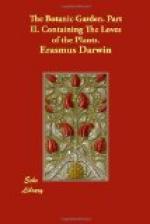But
bright from earth amid the troubled air
Ascends
fair COLCHICA with radiant hair,
215 Warms the cold bosom of the hoary year,
And
lights with Beauty’s blaze the dusky sphere.
Three
blushing Maids the intrepid Nymph attend,
And
six gay Youths, enamour’d train! defend.
So
shines with silver guards the Georgian star,
220 And drives on Night’s blue arch his glittering
car;
Hangs
o’er the billowy clouds his lucid form,
Wades
through the mist, and dances in the storm.
[Colchicum autumnale. I. 214. Autumnal Meadow-saffron. Six males, three females. The germ is buried within the root, which thus seems to constitute a part of the flower. Families of Plants, p. 242 These singular flowers appear in the autumn without any leaves, whence in some countries they are called Naked Ladies: in the March following the green leaves spring up, and in April the seed-vessel rises from the ground; the seeds ripen in May, contrary to the usual habits of vegetables, which slower in the spring, and ripen their seeds in the autumn. Miller’s Dict. The juice of the root of this plant is so acrid as to produce violent effects on the human constitution, which also prevents it from being eaten by subterranean insects, and thus guards the seed-vessel during the winter. The defoliation of deciduous trees is announced by the flowering of the Colchicum; of these the ash is the last that puts forth its leaves, and the first that loses them. Phil. Bot. p. 275.
The Hamamelis, Witch Hazle, is another plant which flowers in autumn; when the leaves fall off, the flowers come out in clusters from the joints of the branches, and in Virginia ripen their seed in the ensuing spring; but in this country their seeds seldom ripen. Lin. Spec. Plant. Miller’s Dict.]
GREAT
HELIANTHUS guides o’er twilight plains
In
gay solemnity his Dervise-trains;
225 Marshall’d in fives each gaudy band
proceeds,
Each
gaudy band a plumed Lady leads;
With
zealous step he climbs the upland lawn,
And
bows in homage to the rising dawn;
Imbibes
with eagle-eye the golden ray,
230 And watches, as it moves, the orb of day.
[Helianthus. l. 223. Sun flower. The numerous florets, which constitute the disk of this flower, contain in each five males surrounding one female, the five stamens have their anthers connected at top, whence the name of the class “confederate males;” see note on Chondrilla. The sun-flower follows the course of the sun by nutation, not by twisting its stem. (Hales veg. stat.) Other plants, when they are confined in a room, turn the shining surface of their leaves, and bend their whole branches to the light. See Mimosa.]




